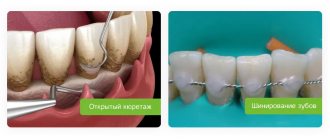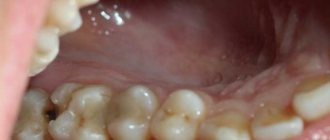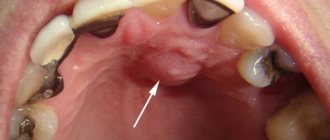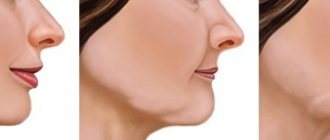The diagnosis of “wedge-shaped dental defect” is associated in most patients with a wedge-shaped depression at the base of the tooth. But not every cervical defect is wedge-shaped. Moreover, the disease refers to non-carious lesions that require a special approach to treatment. In the “Smile Factor”, the doctor will identify the prerequisites for the formation of such defects, and if the integrity of the dental tissues is already compromised, he will conduct a thorough diagnostic search and restore the tooth using modern techniques.
Restoration. Repairing a chipped front tooth
Direct restoration
Indirect restoration
Restoration of the incisal edge
Selection of material for restoration
A chipped or broken front tooth is not a pleasant occurrence, from which no one is immune. Such an “accident” can happen at any time, even while eating. And how can you smile if instead of a whole tooth there is only half left? Fortunately, you can restore the beautiful shape of your teeth very quickly. This method is called restoration. What it is, what it is like, the main indications - this is discussed in our article.
Dental restoration is a special type of dental services aimed at improving the aesthetics of a smile. This procedure solves several problems at once: it improves the appearance of teeth, gives anatomical shape and restores the function of a damaged tooth.
There are direct and indirect restorations.
Stages of cervical caries
Cervical caries develops according to the same scenario as other types of this disease, but much faster. Let us describe the stages of development of root caries:
- Initial (white spot stage). It is asymptomatic. A demineralized area of enamel forms in or under the gum area. It looks like a white or chalky spot. Gradually it begins to fade, but this is difficult to notice with the naked eye, especially if the pathology is localized on the back surface of the tooth or on the molars and premolars. If it starts under the gum, then it can only be detected using hardware diagnostics.
- Superficial. The carious spot becomes larger and acquires a yellowish or brownish tint. Destructive processes begin on the tooth surface. At this stage, the pathological focus has not yet spread to hard tissue. The patient may experience discomfort when eating sweet foods. It disappears immediately after the stimulus is removed. Often people attribute this symptom to increased sensitivity of the gums.
- Average. Damage to hard tissues is observed. A person experiences severe discomfort when eating sweet, sour, cold or hot foods. Possible pain. These signs disappear as soon as you brush your teeth.
- Deep. The last stage is an advanced form of the disease. Deep damage to dentin occurs. The pathological process involves the tooth root and pulp. The tooth may split into several parts or break in the neck area. The patient almost constantly experiences pain, which painkillers do not help eliminate.
Treatment for caries can vary depending on the degree of damage to the tooth. The method is selected individually after diagnosis.
Direct restoration
During direct restoration, the doctor places a filling material on the tooth. It is comfortable and flexible, able to take the shape specified by the dentist. The color does not differ from the shade of native enamel, and at the same time it is highly durable.
This method is suitable for minor corrections:
- restoration of chipped front teeth;
- crack in the enamel;
- tooth restoration after removal of fragments destroyed by caries;
- color correction;
- gap between teeth.
Stages of direct restoration
- The doctor places a rubber dam on top of the tooth. This is a device made of latex and a holding frame. It is necessary to prevent saliva and germs from getting onto the work area, otherwise this will worsen the properties of the filling material.
- Selection of enamel shade.
- Restoration of teeth with filling material using a matrix. This is a dental instrument that allows you to recreate the anatomy of a tooth. Using the matrix, the doctor verifies the contact gaps between the teeth and maintains the boundary of the layer-by-layer application of the composite.
- Carefully polish the tooth using a brush and paste.
Before the procedure, professional oral hygiene is required. It cleans teeth of plaque and microbes and makes it possible to accurately determine the color of the enamel.
Advantages
- Efficiency. Tooth restoration can be done in one appointment.
- Naturalness. The shade is selected in accordance with the shade of your natural teeth.
- Safety. The affected tooth does not require grinding; neighboring teeth also remain unharmed.
One of the disadvantages is that over time, teeth restored with composite material may become dull. Most often this happens due to non-compliance with hygiene rules and the wrong choice of toothpaste.
Artistic restoration of teeth
What factors provoke the destruction of tooth enamel?
The integrity of tooth enamel also depends on the quality of hygiene procedures when using the “correct” brush. If food debris and soft plaque are not removed from the surface of the teeth in a timely manner, acid-forming pathogenic bacteria begin to actively multiply in them. In this case, the acidity of the environment increases sharply, and under the influence of acid, demineralization of the enamel coating occurs. The loss of calcium leads to the destruction of enamel and the looser and softer dentin located underneath.
It has been noted that a wedge-shaped defect is often formed:
- abuse of carbonated drinks and sour juices;
- in patients with malocclusion - due to non-physiological movement of the jaws chewing food and increased chewing load on individual teeth;
- when correcting the bite with braces;
- in patients with periodontal diseases, accompanied by subsidence of inflamed gums and, accordingly, exposure of the necks of the teeth.
Even properly selected treatment helps to avoid undesirable consequences only if the problem is identified at an early stage. Therefore, patients should promptly seek dental care when the very first signs of pathology are detected.
Restoration of the incisal edge
Enamel is the hardest tissue in our body. But over time, it becomes thinner, including due to improper brushing techniques or the use of abrasive pastes. This is fraught with the appearance of microcracks and chips on it. Especially at risk are those who have bad habits: chewing seeds, nuts, or the tip of a ballpoint pen. Restoration of the cutting edge of the tooth helps to correct the shape of the tooth and its cutting edge, and hide enamel defects.
This is not an easy procedure that requires painstakingness and creativity, because the anatomical shape of everyone’s teeth is different. In addition, the tooth has a relief, individual shade and transparency. The specialist’s task is to make sure that the restored tooth does not differ from the rest.
Front Tooth Reconstruction. Source: Futurism YouTube channel
Few people know that the color of the enamel changes from the neck to the cutting edge. It seems that the changes are insignificant, but if this feature is not taken into account, the restored tooth will look like a plastic crown. The same can be said about transparency.
What symptoms of a wedge-shaped defect should you pay attention to?
Painful sensations during caries appear when destroyed dental tissues (the so-called carious cavity) are no longer able to protect the neurovascular bundle located in the pulp chamber. With a non-carious defect, the affected area and decaying dentin are covered by the gum, and the walls of the formed wedge-shaped cavity remain smooth and hard. Therefore, the patient does not begin to experience unpleasant sensations immediately, but only in the third or fourth stages. Treatment of advanced pathology turns out to be more complex, costly, and in some cases ineffective.
Therefore, you should definitely see your doctor if you have:
- individual teeth have become hypersensitive and react to external irritations with sharp, piercing pain;
- the enamel has become cloudy, pale or more pigmented;
- The gum line has changed and the necks of the teeth are exposed.
Selection of material for restoration
For direct tooth restoration, special composite materials are used, which have high strength, ductility, and also help achieve the effect of tooth transparency.
Most popular materials:
- Filtek (USA) - considered a universal material. It is suitable for restoring anterior teeth and chewing teeth. The main thing is to choose the right shade.
- Venus (Germany) is a more expensive option for the restoration of anterior teeth. The material consists of nanoparticles, which helps to achieve maximum aesthetic effect.
- Enamel Plus (Italy) - sometimes it is called a “chameleon” for its ability to adapt to its native enamel color.
- During indirect restoration, ceramics, zirconium dioxide, and metal ceramics are used.
How is cervical caries diagnosed?
If the carious lesion is localized on the visible part of the tooth, the doctor makes a diagnosis after an external examination. But to confirm it, a special test is performed using a dye solution. It is applied to the enamel and left for 3-4 minutes. The affected area turns blue. After a few hours, the dye is completely washed out of the mouth.
The doctor may also prescribe an x-ray to assess the nature of the spread of caries, the depth of the carious cavity, the condition of the nerve endings, etc. Based on the results of the examination, a treatment method is selected. It is determined, first of all, by the stage of the disease.
What you can do at home
We described the features of caries treatment at different stages in the dentist's office. Many people are interested in the question of what to do if the disease develops at home, whether it can be stopped on their own. The only thing available to the patient is prevention. If a carious lesion has already begun, it is impossible to reverse it with the help of rinses or folk remedies.
However, you can slow it down or stop it if you follow a number of simple rules:
- brush your teeth twice a day and rinse your mouth after eating;
- give up sweet foods and sodas;
- quit bad habits, in particular smoking;
- use irrigators to clean the oral cavity.
In addition, do not forget to check your teeth every six months, even if you are not worried about caries symptoms.
All problems can be solved
An even dentition, white teeth of regular shape adorn any person and serve as an integral part of an ideal smile. Thanks to this, everyone can feel attractive, because in the modern world almost any dental defect can be successfully corrected. Thanks to this, many patients are able to return to normal life. Therefore, if you are concerned about the presence of a diastema, this imperfection can be corrected quite quickly and painlessly in dentistry near the Krasnye Vorota, Baumanskaya, Novokuznetskaya and Tretyakovskaya metro stations. Do not be indifferent to your health and psychological state, and confidently contact dental specialists to solve your problems.
How is advanced cervical caries treated?
Deep caries is often accompanied by damage to the pulp, so depulpation is required. After this, root canal treatment and filling are performed. In some cases, nerve removal can be avoided. Then treatment is carried out according to the standard algorithm:
- Anesthesia.
- Removal of deposits and tartar.
- Selecting the shade of the future filling.
- Retraction of the gingival margin.
- Preparation of a carious cavity.
- Tooth isolation.
- Grinding.
- Filling.
- Polishing the filling.
The procedure can be more complicated if the carious lesion is located under the gum. It has to be cut to open access to the neck and root. After the main treatment, the doctor applies sutures, which dissolve within a few days.
If the patient goes to the doctor late and the tooth is almost completely destroyed, it is removed. The question arises about installing an implant.










